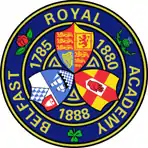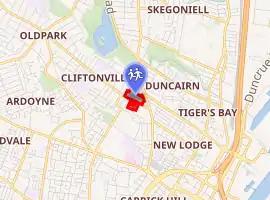Belfast Royal Academy
The Belfast Royal Academy (commonly shortened to B.R.A) is the oldest school in the city of Belfast, Northern Ireland.[1] It is a co-educational, non-denominational voluntary grammar school situated in north Belfast. The Academy is one of 8 schools in Northern Ireland whose Head is a member of the Headmasters' and Headmistresses' Conference
| Belfast Royal Academy | |||||
|---|---|---|---|---|---|
 School Crest | |||||
| Address | |||||

| |||||
5-17 Cliftonville Rd , Antrim , BT14 6JL | |||||
| Information | |||||
| Type | day grammar school | ||||
| Motto | per vias sapientiae (Latin "along the roads of wisdom") | ||||
| Religious affiliation(s) | non-denominational | ||||
| Established | 1785 | ||||
| Founder | Rev. Dr. James Crombie | ||||
| Warden of the Board of Governors | K.A.Knox Esq. MSc. | ||||
| Headmistress | Mrs Hilary Woods | ||||
| Gender | Male and Female | ||||
| Age | 11 to 18 | ||||
| Enrolment | 1,400 (approx.) | ||||
| Houses |
| ||||
| Colour(s) | Maroon and& Navy | ||||
| Publication | The Owl | ||||
| Affiliations | HMC | ||||
| Website | www.belfastroyalacademy.com | ||||
History
The Academy was founded in 1785 by Rev. Dr. James Crombie. Originally situated near St Anne's Parish Church in what is now Academy Street, it moved to its current location on the Cliftonville Road in 1880. For more than a century the school was named Belfast Academy. On 27 November 1887, Queen Victoria granted permission for the school to style itself Belfast Royal Academy, and its name was officially changed in November 1888.[2]
"Barring out" incident
On 12 April 1792, a group of schoolboys (eight boarders and two day boys) barricaded themselves in the mathematics classroom. In doing so they “declared war against the masters until their requests should be granted”.[3] As they expected to be holed up for some time, they had taken a quantity of provisions from the academy kitchens; further they managed to arm themselves with 5 pistols and a large quantity of gunpowder and shot. A letter, headed “Liberty Hall”, was sent by the students to their masters in which they stated they would not surrender until their demands had been met. The academy authorities, in an attempt to break the siege, sent workmen to break down the door and pour water down the chimney, without success, as the boys opened fire on them. Finally the Sovereign of Belfast, Rev. William Bristow, was summoned, he “read the Riot Act” to the boys but failed to end the barring out, and one of the boys opened fire on him.[3]
The siege ended by negotiation between the governors and the boys soon after; the boys, however, refused to show remorse and were later beaten and then expelled.
Headmasters
- Rev. James Crombie, DD, (Universities of St Andrews and Glasgow) (1785–1790)[4]
- Rev. William Bruce, DD, (Trinity College, Dublin and the University of Glasgow) (1790–1822)
- Rev. James Gray, DD, (1822–1826)[4]
- Rev. Reuben John Bryce, MA, LLD, (University of Glasgow) (1826–1880)[4]
- Dr William Collier, LLD, (Trinity College, Dublin) (1880–1890)[4]
- Mr T. W. Foster, MA, (Trinity College, Dublin) (1890–1898)[4]
- Mr T. R. Collier, MA, (Queen's College, Belfast) (1898–1923)[4]
- Mr Alexander Foster (rugby union) MA, (Queen's University, Belfast) (1923–1942)[4]
- Mr John Darbyshire, MA, (University of Liverpool) (1943–1968)[4][5]
- Mr Louis Lord, MA, (Trinity College, Dublin) (1968–1980)[4][5]
- Mr William Sillery, MA, (St. Catharine's College, Cambridge) (1980–2000)[4][5]
- Mr William Young, MA, (Queen's University, Belfast) (2000–2008)[4][5]
- Mr Moore Dickson, MA, (Pembroke College, Cambridge) (2009–2017)[5]
- Mrs Hilary Woods, BSc, (Stranmillis College, Belfast and the University of Ulster) (2017– )[5]
School crest
The school crest comprises the rose, the thistle and the shamrock, along with the Royal Coat of Arms of the United Kingdom, the Arms of the City of Belfast and those of the Province of Ulster. The three significant dates mark the foundation of the school in 1785, the transfer to the present site in 1880 and the approval by Queen Victoria of the designation Belfast Royal Academy in 1888.[2]
Preparatory department
The school's preparatory department, Ben Madigan Preparatory School, is located on the Antrim Road in the shadow of Cave Hill. Originally opened in 1829, it moved to its current site in 1965. A pre-prep was opened in 1998.
House system
When a pupil enters the Academy he or she is placed into one of the four houses: Shaw, Currie, Pottinger or Cairns, named after distinguished past pupils: James Shaw, Donald Currie, Henry Pottinger, and Hugh Cairns, 1st Earl Cairns, for whom the house colours are yellow, green, red, and blue, respectively; each pupil must wear a tie with a stripe of his or her house colour on it.[2]
Honours system
As a pupil progresses through the Academy, he or she can earn honours through excellence in sport and/or the arts. There are minor honours, allowing a pupil to wear a minor honours tie, (green owls) intermediate honours (blue owls) and major honours (gold owls). In addition, a pupil gaining intermediate honours is entitled to wear a black blazer with maroon braid surrounding a golden school badge. A pupil gaining major honours in sport is entitled to wear a distinctive maroon blazer with blue braid and a gold school badge. Pupils who receive major honours in the arts, be it for music, drama, or art & design are entitled to wear a blue blazer with maroon braid and a gold school badge. The honour, e.g. Cricket XI 2004 or Music 2002, is stitched in gold letters under the badge for both intermediate and major honours.
Notable alumni
- William Hamilton Drummond (1778–1865), Presbyterian minister and poet
- William Bruce (1790–1868), Presbyterian minister
- Robert Henry Charles (1855–1931), clergyman and biblical scholar
- Owen Thomas Lloyd Crossley (1860–1926), Bishop of Auckland, 1911–13
- John Ward Armstrong (1915–1987), Dean of St. Patrick's Cathedral, Dublin, 1958–68, Bishop of Cashel, Emly, Waterford and Lismore, 1968–77, Bishop of Cashel and Ossory, 1977–80, and Archbishop of Armagh and Primate of All Ireland, 1980–86
- Robin Eames, Baron Eames of Armagh (born 1937), Archbishop of Armagh and Primate of All Ireland, 1986–2006
Academia and Science
- Alexander Mitchell (1780–1868), blind civil engineer and inventor of the screw-pile lighthouse
- James Lawson Drummond (1783–1853), Professor of Anatomy and Medical Physiology, Royal Belfast Academical Institution, 1819–49
- John Thomas Romney Robinson (1792–1882), Director, Armagh Observatory, 1823–1882
- Robert Patterson FRS (1802–1872), naturalist
- Sir James Emerson Tennent (1804–1869) FRS politician and traveller
- Thomas Andrews (1813–1885), Professor of Chemistry, Queen's College, Belfast, 1845–1879, and physician
- Bowman Malcolm (1854–1933), railway, civil and mechanical engineer
- Denis Weaire, (born 1942), FRS Erasmus Smith's Professor of Natural and Experimental Philosophy, Trinity College, Dublin, and physicist
- James Stirling, CBE, FRS, Provost of Imperial College London and former Jacksonian Professor of Natural Philosophy, University of Cambridge
- Stephen D. M. Brown, FRS, FMedSci is director of the Medical Research Council (MRC) Mammalian Genetics Unit, MRC Harwell at Harwell Science and Innovation Campus, Oxfordshire
- Dame Nicola Brewer, DCMG, Vice-Provost (International) University College London British High Commissioner to South Africa 2009–2013
- Ian White, MA, PhD, FREng, Master of Jesus College, Cambridge, van Eck Professor of Engineering, and Deputy Vice Chancellor University of Cambridge
- Geoffrey Beattie - Professor of Psychology
- Paul Seawright (born 1965), photographer and academic
Politics
- Lieutenant-General Sir Henry Pottinger (1789–1856), Envoy and Plenipotentiary to China, 1840–43, first Governor of Hong Kong, 1843–44, and Governor of Madras, 1847–54
- Hugh Cairns, 1st Earl Cairns (1819–1885), Lord Chancellor, 1868, 1874–80
- Joseph Gillis Biggar (1828–1890), Irish Home Rule MP for County Cavan, 1874–90
- James Bryce, 1st Viscount Bryce (1838–1922), jurist, historian and politician.
- Kate Hoey (born 1946), Minister for Sport, 1998–2001, MP for Vauxhall, 2001–2019
- Basil McCrea UUP member of the Northern Ireland Assembly
- Nelson McCausland DUP member of the Northern Ireland Assembly and Minister of Culture, Arts and Leisure 2009–
- Samuel MacCurdy Greer (1810–1880), MP for County Londonderry 1857–59
- Sir Francis Evans (1897–1983), Ambassador to Israel, 1952–54, Ambassador to Argentina, 1954–57, and Agent for the Government of Northern Ireland in London, 1962–66
Law
- Sir Samuel Ferguson (1810–1886), poet, barrister and antiquarian
- John Atkinson, Baron Atkinson (1844–1932), Lord of Appeal in Ordinary
- Sir Donald Murray (born 1923), Lord Justice of Appeal of the Supreme Court of Northern Ireland
- Sir Paul Girvan (born 1948), Lord Justice of Appeal of the Supreme Court of Northern Ireland
Business
- George Benn (1801–1882), historian of Belfast, and distiller
- Sir William Ewart (1817–1889), linen manufacturer
- John Mulholland, 1st Baron Dunleath (1819–1895), textile manufacturer
- Sir Donald Currie (1825–1909), founder and owner, Castle Shipping Line, 1862–1900, and Union-Castle Line, 1900–09, and politician
- Samuel Cunningham (1862–1946), businessman and Senator of the Parliament of Northern Ireland, 1921–45
Media and Arts
- Abeer MacIntyre (born 1964), Journalist, Broadcaster and Charity Worker
- Charles Williams (1838–1904), first Editor, Evening Standard, 1860–63, first Editor, Evening News, 1881–84, and war correspondent
- Douglas Gageby (1918–2004), Editor, Evening Press, 1954–63, and Editor, Irish Times, 1963–86
- John Cole (1927–2013), Political Editor, BBC, 1981–92
- Ali McMordie (born c.1957), musician, founding member of Stiff Little Fingers
- William Crawley, BBC radio and television presenter
- Peter Dickson, (born c. 1957), radio presenter, television announcer
- Tony Macaulay (writer) (born 1963) Northern Ireland author, leadership consultant, peace builder and broadcaster.
Sport
- Jack Kyle (1926-2014), Ireland and British Lion rugby union player
- Marty Smyth, professional poker player
- Iain Henderson (born 1992), British and Irish Lion and Ireland rugby union player
- Henry Morgan (1907-1987), Ireland first-class cricketer
Military
- P. Dean McFadden (born 1957) CMM, CD, Vice-Admiral and Chief of the Maritime Staff 2009-2011
- Sir 'Timo' Anderson, KCB, DSO, FRAes, RAF, Air Marshal and former Director General of the Military Aviation Authority
- Major General Sir Eric Girdwood KBE (1876–1963) Commandant of the Royal Military College Sandhurst and General Officer Commanding Northern Ireland District.
Sources
- Belfast Royal Academy: The First Century 1785–1885, by A. T. Q. Stewart
- "History of the School". Belfast Royal Academy. 2014. Retrieved 6 December 2020.
- "The Academy's 'Easter Rebellion'". Belfast Royal Academy. 2014. Retrieved 6 December 2020.
- "Alumni Newsletter". Royal Belfast Academy. June 2016.
- "Principals". Belfast Royal Academy Old Boys' Association.
References
- Belfast Royal Academy: 1785–1935, by Hugh Jackman
- Belfast Royal Academy: The First Century 1785–1885, by A.T.Q. Stewart
- Belfast Royal Academy: The Second Century 1885–1985, by Edward McCamley
